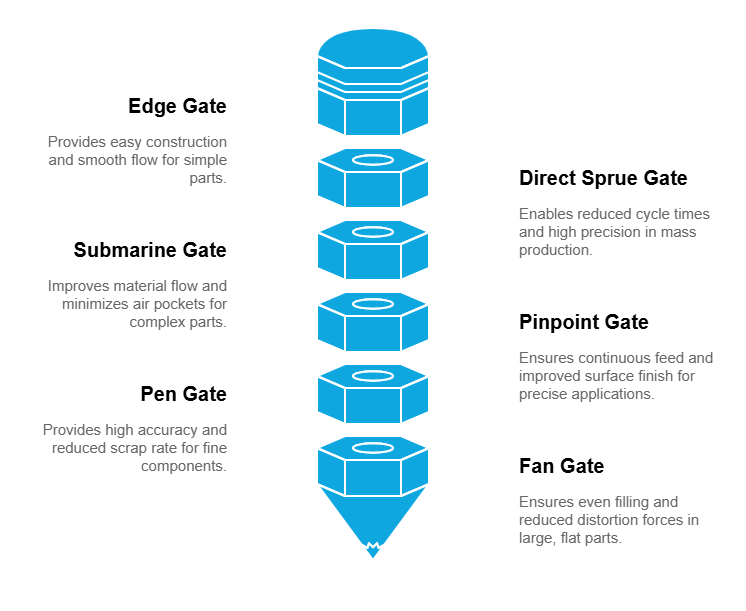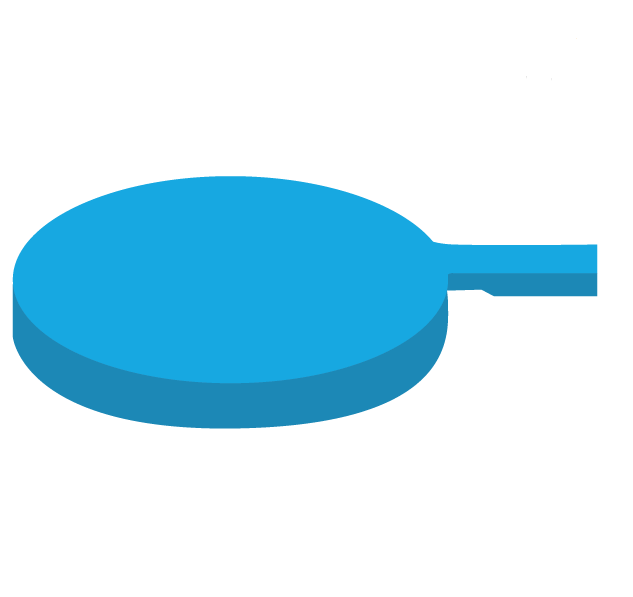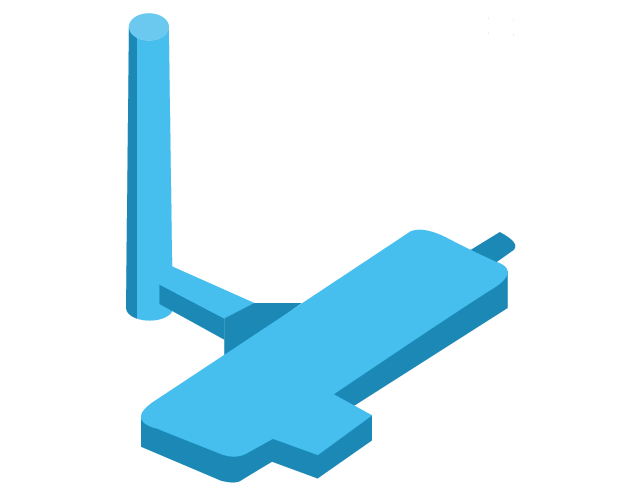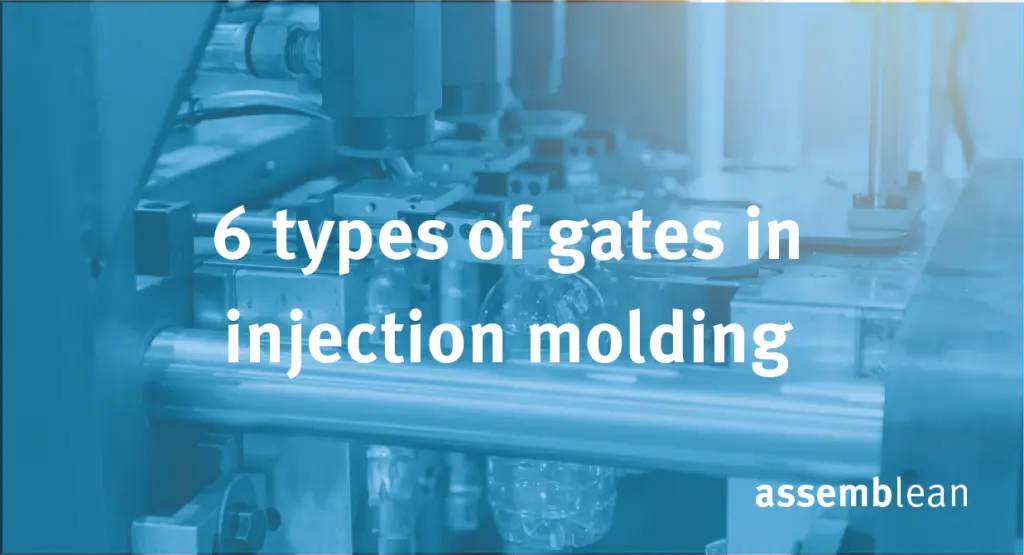Introduction
Injection molding is one of the most frequently used manufacturing processes in the plastics and metal industry. A decisive factor in this process is the design of the sprue system, which controls the material flow from injection to the mold. The choice of the appropriate sprue type significantly influences the quality of the end product, the production speed and the overall cost of the manufacturing process. Six main gate types are presented in this article: Edge Gate, Direct Sprue Gate, Submarine Gate, Hot Pin Gate, Pin Gate and Fan Gate. Each of these methods offers specific advantages and is ideal for different applications.
1. Edge Gate
Definition and structure:
The Edge Gate, also called edge sprue, is one of the simplest forms of sprue. It is located at the edges of the mold and enables a direct flow of material into the cavity.Advantages:
- Simple construction: The tool is easy to manufacture thanks to its placement directly on the mold edge.
- Even flow: The direct entry of the material promotes an even filling process.
Applications:
The edge gate is particularly suitable for simple components with low complexity and symmetrical geometries. It is ideal for prototypes or small series production where tool costs need to be kept low.
2. Direct Sprue Gate
Definition and structure:
Direct gating is a widely used method in which the material is injected directly into the mold without additional channels. In general, the sprue area controls the material flow to the mold.Advantages:
- Reduced cycle times: Direct entry enables faster cooling and therefore shorter production cycles.
- High precision: The minimal material path reduces distortion and inaccuracies.
Applications:
Direct Sprue is ideal for high-precision parts and mass production. It is particularly suitable for components that require high dimensional accuracy and excellent surface quality.3. Submarine Gate
Definition and structure:
The Submarine Gate is a special type of gate that is shaped like a U-shaped tube. This design allows the material to be guided more precisely and minimizes the risk of air pockets.Advantages:
- Improved material guidance: The U-shape guides the material efficiently and reduces turbulence during the flow.
- Reduced risk of entrapment: The design minimizes the risk of porosity and air pockets in the end product.
Applications:
The Submarine Gate is often used for complex components where precise material guidance and high quality are essential. It is particularly suitable for technical components with tight tolerances.
4. Hot Pin Gate
Definition and structure:
The Hot Tip Gate, also known as hot-cut sprue, allows the material to be injected directly at the tip of the mold. By using hot-cut parts, the material remains in a thermally controlled state until it reaches the mold.Advantages:
- Continuous material feed: The hot-cutting technology ensures a constant material flow without interruptions.
- Improved surface quality: Thermal control minimizes surface defects and ensures a smooth surface of the end product.
Applications:
The Hot Tip Gate is ideal for high-precision applications where consistent material quality and a smooth surface are required. It is often used in the automotive and electronics industries.5. Pin Gate
Definition and structure:
The Pin Gate, also known as pin sprue, uses slender pins as entry points for the material. This design enables a precise material flow and targeted filling of the mold.Advantages:
- High precision: The slim pins enable precise positioning of the material flow.
- Reduced reject rate: The precise material guidance minimizes defects, which reduces the reject rate.
Applications:
The Pin Gate is used for fine and complex components that require high dimensional accuracy. It is particularly useful in the manufacture of electronic components and medical devices.6. Fan Gate
Definition and structure:
The Fan Gate is a broad-based sprue method in which the material is injected into the mold in a fan-shaped pattern. This method distributes the material evenly over a larger area.Advantages:
- Even filling: The fan-shaped inlet ensures even distribution of the material, resulting in consistent component quality.
- Reduced distortion forces: The even material distribution minimizes internal stresses and distortion.
Applications:
The Fan Gate is ideal for large and flat components where uniform filling is crucial. It is often used in the production of housings, lids and other large components.
Technical details and practical applications
The choice of the appropriate sprue type depends on various factors, including the geometry of the component, the material properties, the production quantity and the desired surface properties. Careful analysis of these factors is crucial to avoid production problems such as air inclusions, distortion or uneven material distribution.Material flow and temperature control:
An effective gating system not only controls the flow of material, but also influences the temperature of the injected material. For example, the hot tip gate ensures a continuous and controlled temperature, which is particularly advantageous for temperature-sensitive materials.Maintenance and tool costs:
Another important aspect is the maintainability of the gating system. More complex systems such as the Submarine Gate or the Fan Gate may incur higher tooling costs, but offer advantages in production quality and efficiency. In contrast, simpler systems such as the edge gate are more cost-effective, but can lead to quality problems with complex components.Automation and cycle times:
Automation is playing an increasingly important role in modern manufacturing. Gate systems such as direct sprue gate allow for shorter cycle times and are better suited to automated processes, increasing overall productivity.Future trends and industry developments
As technology advances, casting methods also evolve. The use of simulation-supported design processes enables more precise prediction of material flow and optimized design of the gating system. In addition, sustainable and resource-saving production methods are becoming increasingly important, leading to an increased use of renewable materials and a reduction in waste flows.Additive manufacturing:
The integration of additive manufacturing technologies with traditional injection molding processes opens up new possibilities for designing complex gating systems that were previously not possible. This enables even more targeted control of the material flow and a further improvement in component quality.Intelligent manufacturing:
The implementation of artificial intelligence and machine learning in the injection molding process enables dynamic adjustment of the gating systems in real time. This leads to optimization of production processes and improved error detection, which further increases efficiency and quality.Conclusion
Choosing the right sprue is a crucial factor for success in the injection molding process. Edge Gate, Direct Sprue Gate, Submarine Gate, Hot Tip Gate, Pin Gate and Fan gate each offer specific advantages and are suitable for different applications. By carefully analyzing component requirements and production conditions, manufacturers can choose the optimal gating method to maximize the quality, efficiency and profitability of their manufacturing processes. As technological developments continue, these methods will continue to be refined to meet the increasing demands of the industry.👉 If you have any questions or an idea for production, feel free to send us a request!



